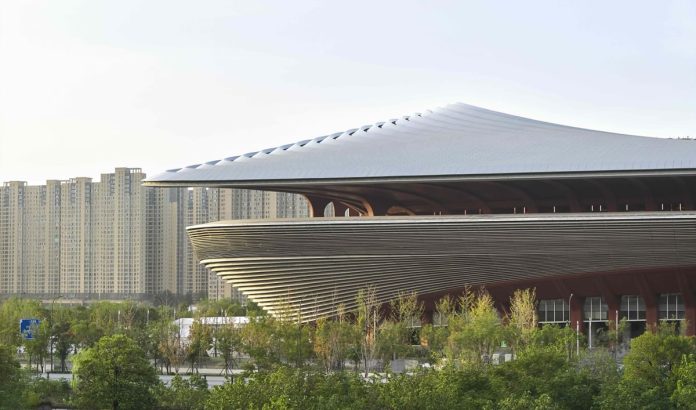anchor
The Prix Versailles has unveiled the names of the six projects included in its 2025 World’s Most Beautiful Arenas list.
“The expectations for these recently inaugurated arenas are lofty. Investing as they do in the future, they are designed to foster intergenerational bonds, international exchanges and local interactions,” said Prix Versailles Secretary General Jérôme Gouadain. “As a result, this type of infrastructure is increasingly expected not only to fit seamlessly into the city and region but also to be receptive to its populations’ aspirations, to be a source of inspiration for visitors and to constitute part of the area’s heritage.”
Three arenas from this list will also receive the further distinction of a World Title – Prix Versailles, Interior or Exterior at a ceremony at the UNESCO Headquarters in December. The announcement of the arena shortlist follows the release of the Prix Versailles’ passenger stations, emporiums, airports, and restaurants shortlists.
Below, you can see and learn more about the recognized arenas for this year. You can also see other shortlisted projects across other categories through our ongoing coverage of the series here.
Xi’an International Football Centre by Zaha Hadid Architects
Xi’an, China

Xi’an International Football Centre by Zaha Hadid Architects. Image credit: Hufton + Crow
Description: “The stadium and training grounds at the Xi’an International Football Centre were built as part of an ongoing nationwide campaign to promote football in China. In Fengdong, the city’s business district, this building from Zaha Hadid Architects lays the foundations for future development in the area around it. An ultra-modern bowl inside the saddle-shaped structure guarantees optimal views for up to 60,000 fans. But more than that, the Centre is above all a new public space. On shaded, south-facing terraces with views of the city and the Qin Mountains, leisure and dining areas are open daily, all day long, for locals as well as visitors coming to town for a match, a concert or a show. The stadium’s sweeping lines were designed to minimise the impact of prevailing winds from the north that chill the city each winter, and a translucent membrane protects spectators from inclement weather and direct sunlight while still allowing maximum levels of natural light to filter through to the pitch.”
SAP Garden by 3XN
Munich, Germany

SAP Garden by 3XN. Image credit: Rasmus Hjortshoj
Description: “How could Munich preserve its illustrious Olympic Park while creating a new and ambitious facility? The architects at 3XN had a clever answer to that question. Spanning 62,500 m², SAP Garden is now home to EHC Red Bull München (ice hockey) and Bayern Munich (basketball). The main bowl can accommodate up to 10,700 hockey spectators or 11,500 for basketball, in grandstands that can be raised or lowered as needed, guaranteeing an optimal experience from every seat. Tucked beneath an artificial hill, three competition rinks that are open to the public help the arena blend into its surroundings and encourage locals to take to the ice. Digital media and lights can change the ambiance in each area, but that’s not all the site has to offer: VIP areas, a restaurant, merchandise shops, offices, a public rooftop terrace and conference rooms all breathe life into the venue, even when no matches are being played. SAP Garden is a sustainable architectural model driven by effective aesthetics, with a green roof and maximised natural light, decked out in colours that shift in time with the seasons and the events.”
Le Colisée by Groupe-6
Chartres, France

Le Colisée by Groupe-6. Image credit: Michel Denancé
Description: “In Chartres, the city’s famous cathedral is the nexus of any urban development. So, it was only fitting that the grand façade and esplanade of Le Colisée – a new, adaptable venue for sport and culture – should elegantly look out towards the house of worship. Designed by Groupe-6 architectes, this ‘colosseum’ (colisée in French), like its namesake in Rome, is located in the heart of the city, while its ambulatory (created like an agora) and its elliptical main hall are reminiscent of ancient theatres. Rather than building it in the suburbs, the district decided to place the facility in a railway wasteland, the kind of place that is usually converted into office clusters. Directly connected to the train station via a footbridge, in keeping with the newly created intermodal transport hub, the semi-subterranean arena follows the natural slope of the site, limiting its visual impact. Its airy rooftop garden and promenade, featuring a wide array of plants, is a special public space for residents and visitors alike.”
Kagawa Prefectural Arena by SANAA
Takamatsu, Japan

Kagawa Prefectural Arena by SANAA. Image credit: Ken’ichi Suzuki
Description: “The poetry that emanates from the Kagawa Prefectural Arena (also known as Anabuki Arena Kagawa) has transformed what was once an incoherent space into a unique landscape in and of itself. Looking out onto the Seto Inland Sea, near Takamatsu’s train station and ferry terminal, this open structure designed by SANAA brings together the existing plaza, park and port, connecting the city and the sea. This harmonious composition, visible from the water and the land alike, includes three separate gymnasiums, each with its own specific proportions, for everything from basketball to martial arts. They are linked together under a single, softly undulating roof that recalls the silhouettes of the small neighbouring islands on the horizon. These wall-less sports halls were created for a social experience, with the stands as a soft boundary, not to mention an abundance of sheltered semi-outdoor spaces. Enclosed within large picture windows, the building is flooded with natural light from every side. Indoors, a subtle palette of pastel colours puts the finishing touch on this new and attractive sport facility.”
Caesars Superdome by Trahan Architects
New Orleans, United States

Caesars Superdome by Trahan Architects. Image credit: Trahan Architects
Description: “Just a short distance from the Mississippi River, the Superdome was one of American football’s very first indoor stadiums and is still the world’s largest fixed dome structure today. Now touted as the Saints’ ‘cathedral’, where the team plays its home games, the venue was added to the National Register of Historic Places in 2016. After the significant damage caused by Hurricane Katrina in 2005, its renovation was eventually entrusted to Trahan Architects, who were tasked with extending the 50-year-old building’s life while restoring it to its former glory. The linchpin of their architectural strategy revolved around the creation of three new corner entrances, each one featuring a light-filled atrium. The interior space, which was considerably augmented without expanding the footprint, gives the stadium an accessible new look. Clad in anodised aluminium rods, it echoes the iconic, golden sculptural form of the Superdome’s exterior. Majestic and timeless, this five-year-long redesign achieves a rare balance between innovation and heritage.”
Intuit Dome by AECOM
Inglewood, United States

Intuit Dome by AECOM. Image credit: Intuit Dome
Description: “For the Los Angeles Clippers, it’s nothing but net, even down to their new sporting home at Intuit Dome, whose spectacular architecture, developed by AECOM, calls to mind the swish of a basketball. Built with the 2028 Summer Olympics and Paralympics in mind, this impressive structure dedicated to basketball is characterised by the immersive experience that it delivers to visitors, enhanced by a multitude of tech-based entertainment options. Open to anyone – be they long-time fans or f irst-time spectators, or a member of a club or association – this facility is a welcome surprise, with its participatory features and its enthusiastic team spirit. Interior design is key here, from the biggest spaces to premium suites and lounges, thanks to the involvement of Rita Konig. Like the murals, digital art installations and sculptures crafted by LA-area artists that are scattered throughout the site, Intuit Dome is prepared to unveil to the world its vision of the arena of the future.”
Some current competitions on Bustler that may interest you…
Kinderspace: Architecture for Children’s Development competition / Edition #3
Register by Wed, Nov 26, 2025
Submit by Mon, Jan 19, 2026
Hospice – Home for the Terminally Ill / Edition #5
Register by Wed, Nov 26, 2025
Submit by Mon, Jan 12, 2026
Museum of Emotions / Edition #7
Register by Thu, Nov 27, 2025
Submit by Mon, Jan 12, 2026
Light of Tomorrow by VELUX 2026
Register by Mon, Mar 30, 2026
Submit by Mon, Apr 6, 2026












